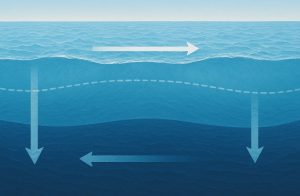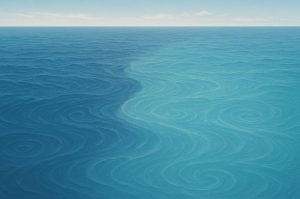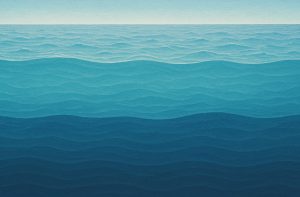At the meeting point of the Pacific and Atlantic Oceans, especially near regions like Cape Horn or the Gulf of Alaska, an extraordinary sight occurs two contrasting bodies of water appear to flow side-by-side without blending.
One might be a deeper blue, while the other appears murky or lighter in tone, separated by what seems like a visible line in the sea.
This unusual phenomenon has circulated widely on the internet, prompting speculation that these two massive oceans somehow “don’t mix.” But is this genuinely the case, or does science tell a different story?
The answer lies in oceanography, a field that studies the physical and chemical properties of Earth’s oceans.
Though the Pacific and Atlantic do mix eventually, the forces behind their apparent separation are deeply rooted in differences in water composition, temperature, salinity, and circulation patterns. This blog dives into the real science behind why the Pacific and Atlantic Oceans appear divided.
Why Pacific and Atlantic Don’t Mix?
To understand the idea that the Pacific and Atlantic Oceans do not mix, it’s essential to differentiate between visual phenomena and physical processes.
What appears to be a hard boundary between the two oceans is, in reality, a temporary separation caused by varying physical properties.
The Pacific Ocean is generally less saline and warmer, especially in its equatorial regions. In contrast, the Atlantic Ocean often has higher salinity levels and cooler temperatures in many areas.
When these waters meet, the differences in density prevent them from mixing quickly.
This is particularly evident in areas where large current systems from both oceans converge, creating visible contrasts in water colour, clarity, and flow.
These contrasts are not permanent but persist long enough to create the illusion of separation.
What Is the Myth Behind the Pacific and Atlantic Oceans Not Mixing?
The myth that the two oceans do not mix has largely been perpetuated by viral images and videos showing the striking difference in colour between adjacent water bodies.
One widely circulated image shows a stark boundary between dark and light water, often mislabelled as the meeting point of the Pacific and Atlantic.
In reality, such images often depict phenomena such as glacial melt mixing with ocean water, sediment-rich rivers meeting the sea, or simply regions of varying plankton concentration. While the images are real, the explanation is usually more nuanced.
The misconception also stems from a lack of understanding about how oceanic systems work.
Many people assume that oceans are homogeneous masses of water, but in fact, they are composed of distinct layers and currents that move in complex ways. This myth highlights the need for public education around marine science.
What Is the Scientific Explanation for Why the Pacific and Atlantic Don’t Mix?
Several scientific principles explain the delayed mixing between the Pacific and Atlantic Oceans, despite them being part of one interconnected global ocean system.
Halocline and Thermocline Layers

The halocline is a boundary layer in the ocean where salinity changes sharply with depth. Similarly, the thermocline refers to a layer where temperature shifts rapidly.
These boundaries act as resistors to water mixing. Because the Atlantic Ocean is generally more saline, its waters are denser than the less saline Pacific waters.
When these two water masses meet, their different densities keep them from blending easily. Instead, they flow beside or on top of each other, maintaining a distinct appearance until turbulent mixing forces them to combine.
Density and Buoyancy
Density differences, largely driven by temperature and salinity, cause one body of water to sit above or beside the other without immediate mixing.
Denser, saltier water from the Atlantic sinks, while the lighter Pacific water stays nearer to the surface, creating a layered structure. Over time, turbulence, wind, and current action mix the waters, but this is a slow process.
How Does Thermohaline Circulation Affect Ocean Mixing?
Thermohaline circulation, often referred to as the global conveyor belt, is a critical factor in long-term ocean mixing. It operates based on the principle that cold, salty water is denser than warm, fresh water.
In the North Atlantic, cold, salty water sinks and flows toward the deep ocean, travelling southward and eventually reaching the Pacific. Meanwhile, surface waters from the Pacific slowly make their way back into the Atlantic.
This global process takes hundreds to thousands of years to complete a full cycle but is the primary mechanism by which ocean waters mix on a planetary scale.
Therefore, while the oceans do not mix immediately or visibly, they are indeed part of a continuous cycle of exchange.
What Physical Boundaries Exist Between the Pacific and Atlantic?

Though there is no physical wall between the Pacific and Atlantic Oceans, natural forces create temporary boundaries.
One such boundary is the convergence zone, a region where different water masses meet. These zones occur near the southern tip of South America and across equatorial and polar regions.
The meeting waters retain their distinct characteristics for some distance due to differences in density and chemical composition.
Another form of boundary is stratification, where water layers with different properties remain separated due to lack of mixing forces.
Stratification is especially strong in areas with minimal wind or wave activity, allowing the water masses to flow side by side.
How Do Ocean Currents Like the Gulf Stream Influence Mixing?
Ocean currents play a major role in maintaining the temporary separation between different water bodies.
The Gulf Stream, for example, carries warm, salty water from the Gulf of Mexico up the east coast of North America and into the North Atlantic.
When this water meets colder, less salty waters from the Arctic or Pacific, a contrast is created.
The temperature and salinity differences reinforce the halocline and stratify the water column. Currents also dictate the direction and speed of mixing, often causing delays in full integration of water masses.
Do the Pacific and Atlantic Oceans Mix at Any Point?
Despite their visible differences and the temporary boundaries that exist between them, the Pacific and Atlantic Oceans do mix, particularly in specific regions. These include:
- The Southern Ocean, near Antarctica, where cold water from both oceans converges and mixes deeply
- The Caribbean Sea, where currents from both oceans contribute to a complex water structure
- The Bering Strait, where the Pacific connects to the Arctic Ocean, which in turn links to the Atlantic
These regions demonstrate that while the mixing might not be instantaneous or complete at surface levels, it is a consistent and ongoing process.
How Do the Pacific and Atlantic Oceans Differ in Properties?
Here is a comparative overview of the two oceans’ characteristics:
| Feature | Pacific Ocean | Atlantic Ocean |
| Surface Area | ~168 million km² | ~106 million km² |
| Average Depth | ~4,280 metres | ~3,646 metres |
| Average Salinity | Lower (especially in the Western Pacific) | Higher (especially in the North Atlantic) |
| Temperature Range | Warmer in equatorial zones | Cooler, particularly in northern zones |
| Current Systems | North & South Equatorial Currents, Kuroshio | Gulf Stream, North Atlantic Drift |
| Marine Biodiversity | High, with large coral reef systems | Rich in migratory species and deep-sea fauna |
What Role Does Ocean Layering Play in Preventing Mixing?

Ocean layering, or stratification, is the formation of distinct layers in a body of water based on temperature and salinity differences. This is a major factor in the delayed mixing of the Pacific and Atlantic Oceans.
During calm weather conditions, the surface layer (less salty and warmer) remains separated from deeper layers (saltier and colder). Without significant wind or wave action, these layers do not mix easily.
In regions where the Pacific and Atlantic waters meet, stratification often reinforces the separation, especially at the surface level.
Only when storms, seasonal upwelling, or turbulence disrupt the stratification does more complete mixing occur.
What Does Modern Oceanography Reveal About Ocean Mixing?
Modern oceanography has made significant strides in understanding how ocean waters interact. Through the use of technologies such as satellite remote sensing, Argo floats, and deep-sea probes, scientists can now track:
- Salinity and temperature changes across vast ocean areas
- Movement of distinct water masses over time
- Effects of climate change on ocean circulation
Institutes like the National Oceanography Centre (UK) and international collaborations under the UNESCO Ocean Decade initiative are leading efforts to better understand and model ocean dynamics.
These studies confirm that while oceans may appear separate at certain points, they are interconnected and constantly undergoing transformation.
Why Is the Concept of ‘Not Mixing’ Both True and False?
The belief that the Pacific and Atlantic Oceans do not mix holds true in a limited, visual sense. Their waters can flow side by side without immediate mixing due to differences in salinity, temperature, and current systems.
However, from a scientific perspective, this separation is temporary. Over time and under the influence of global oceanic circulation, all the Earth’s oceans exchange water, nutrients, and energy.
Thus, the concept is both true in the short term and false over the long term.
Understanding this paradox offers insight into the complexity of our planet’s marine systems, which operate on both immediate and geologic timescales.
Frequently Asked Questions
What is a halocline in oceanography?
A halocline is a zone in the ocean where salinity changes rapidly with depth, creating a barrier that resists vertical mixing of water.
Can the Pacific and Atlantic Oceans ever fully mix?
Yes. While surface waters may remain separate for some time, deep-sea currents and thermohaline circulation ensure eventual mixing over longer periods.
Why do some videos show a clear line between oceans?
This is often due to contrasting colours from sediment, plankton, or salinity differences. It is a visual phenomenon, not a physical barrier.
How does salinity impact ocean currents?
Higher salinity increases water density, causing it to sink and drive deep ocean currents. This movement influences global ocean circulation patterns.
Are there other oceans that don’t mix?
Similar visual phenomena occur elsewhere, such as where the Indian Ocean meets the Atlantic near South Africa, or where rivers meet seas.
What scientific tools are used to study ocean mixing?
Oceanographers use satellites, autonomous floats (like Argo), submersibles, and ship-based measurements to track water movement and characteristics.
How does ocean mixing impact marine life?
Mixing helps circulate nutrients, supports biodiversity, and regulates temperature and oxygen levels essential for marine ecosystems.






